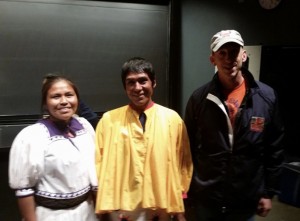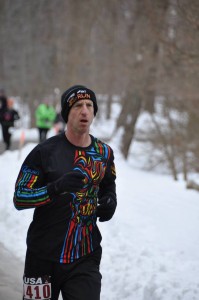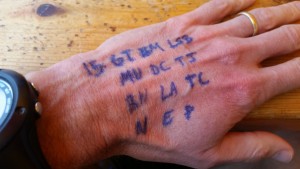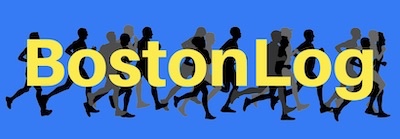On Friday April 15, 2016, I was on the train to Boston to attend a conference on Native American Running presented by Harvard’s Peabody Museum in collaboration with the Boston Athletic Association and other sponsors. This topic has interested me since reading a book by Peter Nabokov which described how Indians ran to communicate, fight, and hunt, as well as interact with spiritual forces. I thought the Indians’ experiences might contain clues to human potential which have been forgotten in today’s technology-obsessed world.

I’m glad I went: the speakers talked about the spiritual and community aspects of running – a welcome contrast to the heavy commercialism of the Boston Marathon Expo. It was a special treat to meet Arnulfo Quimare, the Ruramari runner of Born to Run fame who beat American ultrarunner Scott Jurek in a 50-mile race — and surprising to learn he doesn’t “train” like American runners, but rather developed his running prowess from dancing and walking. He’s happy when running, he stated through a translator, and even happier when he wins.
Out of all the speakers, one comment in particular caught my attention. Chief Oren Lyons is a member of the National Lacrosse Hall of Fame, a distinguished professor of Native American studies at the State University of New York, and a tribal leader in the Onondaga Nation. When asked what advice he gives young Indian athletes, he mentioned a word in the Onondaga dialect, which sounded to me like “jaga.” It meant, he explained, “Try hard — try harder!”
After the conference, I returned to my hotel and prepared to participate in my fourth Boston Marathon. I was a little apprehensive. In 2015 I had set a new personal record at Boston, indeed every race I ran that year was a new record, whether the distance was 5k or 100 miles — until August, when things went wrong at the Beast of Burden 100-mile race. I struggled through September and October with injuries, which healed soon enough, but training was disrupted. At the New York Marathon my time slipped by ten minutes. I vowed to come back.

But I got distracted. Once out of the groove with high-intensity speedwork, it’s hard to get back in. Instead of hitting the track, I participated in ultramarathons in Tennessee and California and took advantage of a warm winter to explore the Catskills.
By the time March rolled around, I realized with horror I hadn’t run mile repeats or 800-meter intervals in almost a year. With only two weeks until Boston, I squeezed in a set of Yasso splits, at a slower pace than what I recalled from the last time I had run them…and hoped for the best.
Then another problem surfaced. After sitting for hours on the train and then at the conference, the next morning I woke up with a strain in my back. No major damage, but the offended muscle was extremely painful. I showed up at the start of the Boston Marathon with two ibuprofen in my pocket, which is not a best practice.

However, I did have in place a special strategy, inspired by what I had heard at the conference. I had identified a list of running friends who I thought would care about my performance, and dedicated to each of them a single mile in the second half of the race. During that mile, I’d call on them in my mind and imagine their guidance and encouragement
The race started, and off I went, and for the first six miles, everything was on plan. But then things began to slip. Passing the half-way point, I began calling on my friends for their guidance. No one criticized me for being off plan, or so I imagined, they just encouraged me to stay focused and make a strong effort. I tried my best, slipped further off plan, and finished in 3:14, almost seventeen minutes slower than the year before.
I was pleased to complete my 72nd race of marathon distance or longer, and I enjoyed spending the weekend in Boston with my wife — but no, I wasn’t happy with this performance.
What had gone wrong? Maybe it was too many goals, too many slow-paced adventures in the Catskills, not enough speedwork (although interestingly when I went back and checked, those Yasso splits were actually faster than the year before), so let’s say more specifically, not enough tempo runs in the three-to-five mile range at just faster than marathon pace. Perhaps.
Sometimes analysis gets you only so far. In these cases, when you fall short of your goal, there’s only one thing you can do: Try hard — try harder!
Kenneth Posner
New York, New York
April 18, 2016
Age – 52
Bib # 3804
3:14:51
Follow Kenneth Posner on his blog TheLongBrownPath.com
